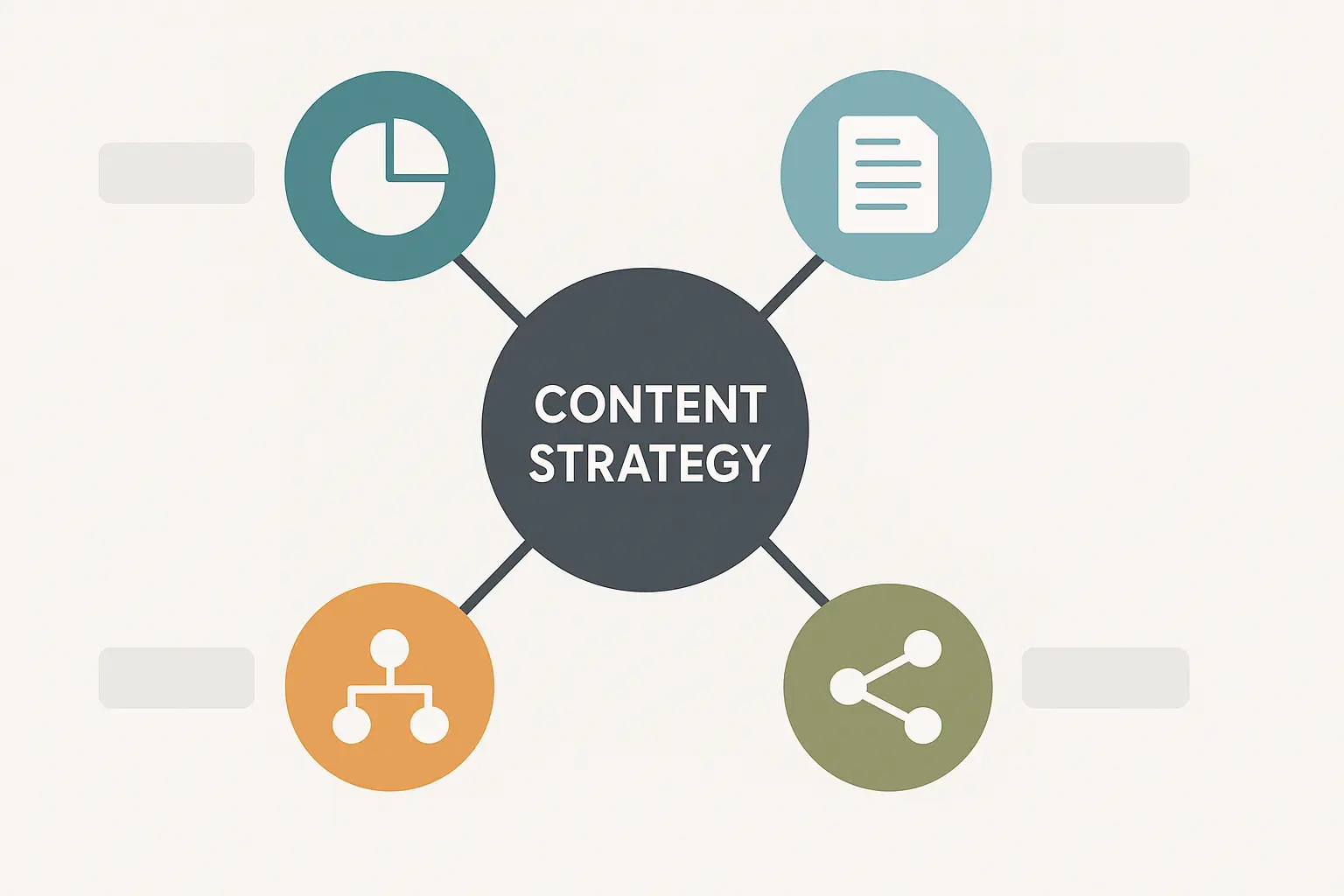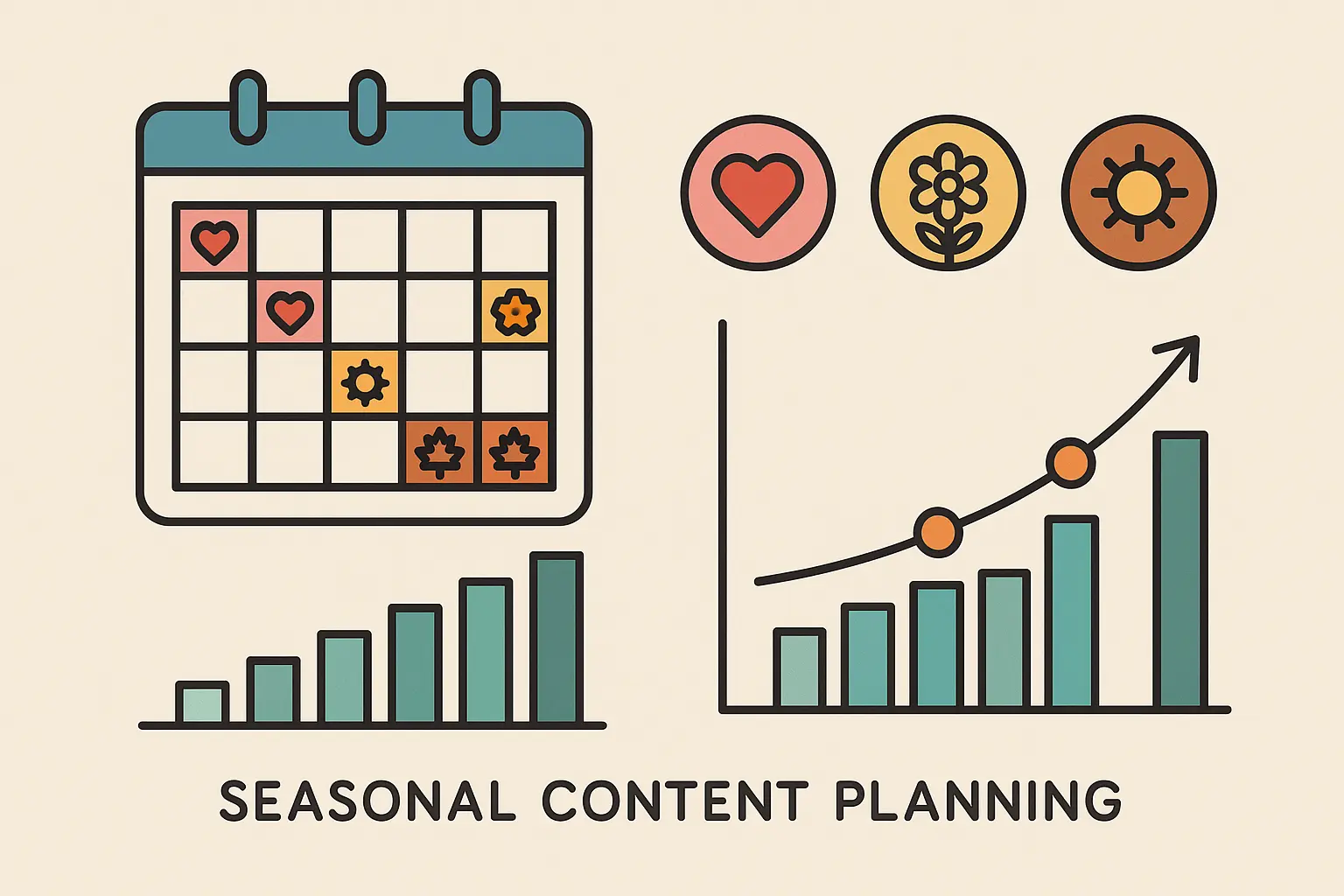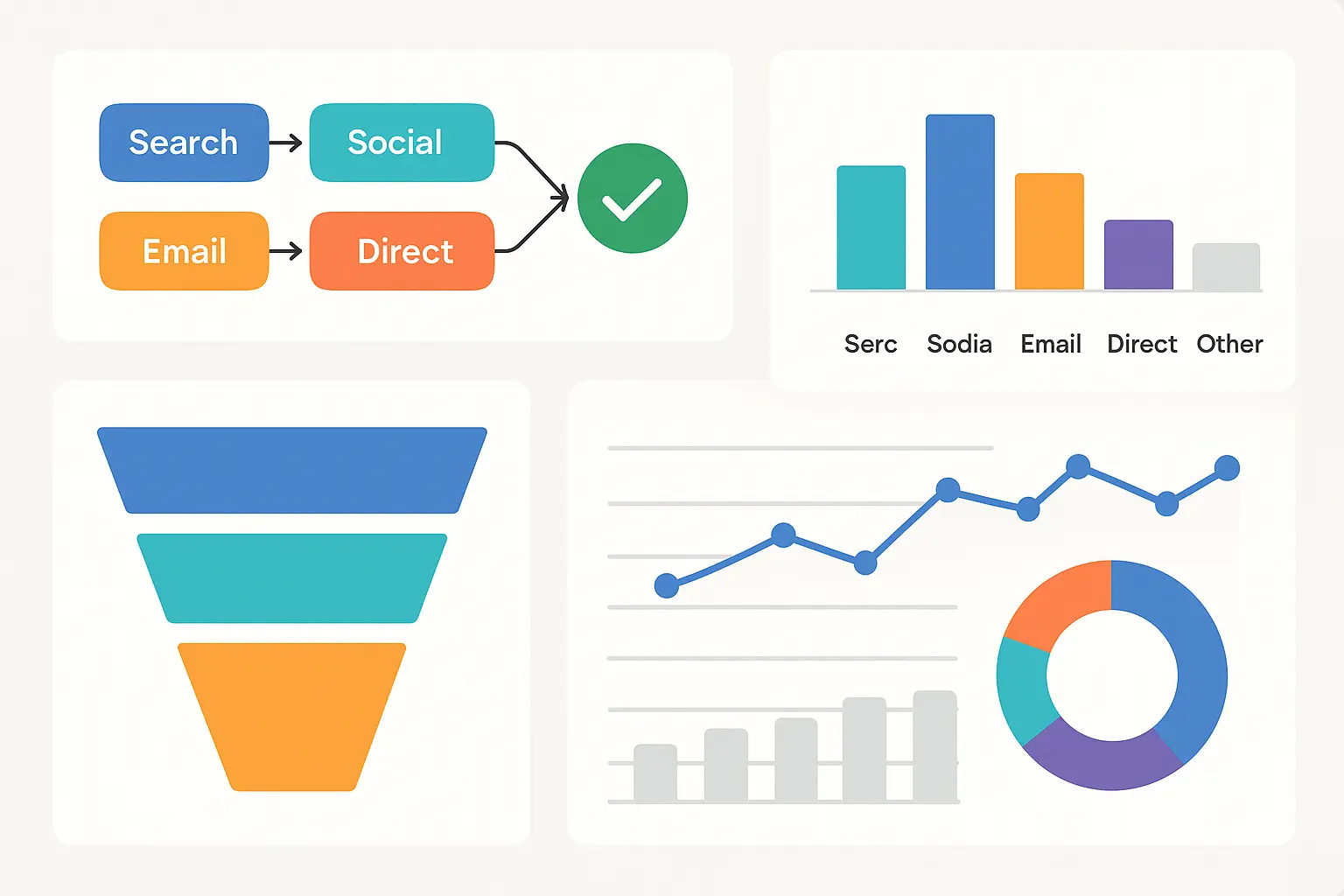Table of Contents
- Building a Smart Foundation for Blog Ideas
- How to Actually Find Ideas People Want
- Making Sure Your Ideas Don’t Suck
- Simple Systems for Coming Up with Ideas Regularly
- Finding Inspiration That Actually Works
- Making Your Content Actually Work
- Getting Your Stuff Published and Seen
- Final Thoughts
TL;DR
- Stop throwing blog post ideas at the wall and start figuring out what your audience actually wants to read
- Use simple research methods and check out what your competitors are doing to find gaps you can fill
- Test your ideas with basic keyword research and data before you waste time writing posts nobody will read
- Use simple systems to brainstorm ideas regularly instead of panicking every time you need to publish
- Turn customer questions, support tickets, and trending topics into blog posts that actually help your business
- Make sure every blog post has a purpose beyond just filling your content calendar
- Focus on writing well, staying consistent, and getting your content in front of the right people
Building a Smart Foundation for Blog Ideas
I used to think coming up with blog topics was just about brainstorming cool ideas. With around 22,000 people in the US searching Google for ‘How to start a blog’ each month according to Ahrefs data, it’s clear that tons of people are looking for help with content creation. Turns out, that random approach leads to content that nobody reads.
Here’s what I learned the hard way: you need to treat finding blog topics like a real process, not just a creative free-for-all. You need both sides working here – the creative side helps you find interesting angles that don’t put people to sleep, and the analytical side makes sure you’re not wasting your time on stuff nobody cares about.
I once spent 8 hours writing a post about “advanced email segmentation strategies” that got 12 views. Turns out nobody was searching for that. My audience just wanted to know how to write subject lines that don’t suck.
When you combine these approaches, you actually create content that moves the needle. The shift from random brainstorming to having a plan isn’t just about being more organized (though that helps). It’s about understanding that every piece of content should serve a purpose beyond just filling your editorial calendar.
Each blog post becomes an investment in your brand’s authority, your audience’s trust, and your business goals. When developing a systematic approach to content creation, understanding how to identify high-impact blog topics becomes crucial for maximizing your content’s effectiveness and reach.

How to Actually Find Ideas People Want
Figuring Out What Your Readers Care About
Your audience has all the answers – you just need to know where to look. I’ve found that the best blog post ideas come from actually listening to what people are saying, asking, and struggling with rather than guessing what might interest them.
Demographics tell you who your readers are, but the good stuff – the psychographics – reveal why they care about certain topics. Behavioral data shows you how they actually consume content. When you combine these three, you get a complete picture of what topics will actually resonate.
Understanding What People Really Want When They Search
Search intent reveals the “why” behind every Google search. Someone searching “how to create a budget” has totally different needs than someone searching “best budgeting apps.” Understanding these differences helps you create content that actually satisfies what people are looking for.
Some searches are just for learning stuff. Others want to find a specific website. Some people are researching before they buy something. Others are ready to take action right now. Match your topics to these different needs, and you’ll see way better engagement.
| What People Want | What They’re Trying To Do | What Kind of Content They Need | Example Search |
|---|---|---|---|
| Learn something | Get educated | How-to guides, tutorials, explainers | “how to start a blog” |
| Find a specific page | Go somewhere they know exists | Brand pages, product pages | “WordPress login” |
| Research before buying | Compare options | Reviews, comparisons, lists | “best email marketing tools” |
| Buy something or take action | Make a decision | Product pages, sign-up forms | “buy domain name” |
Listening to What People Actually Say Online
Social media conversations are goldmines for blog post ideas. People share their frustrations, ask questions, and complain about stuff openly. I spend time in Facebook groups, LinkedIn discussions, and Reddit threads where my audience hangs out.
The key isn’t just watching for mentions of your brand. Look for the same complaints popping up over and over, questions that keep getting asked, and heated debates in your industry. These conversations show you what people actually care about right now, not what they cared about six months ago when you planned your content calendar.
The rise of AI tools has totally changed how marketers think about coming up with topics. According to “Exploding Topics”, “marketers are already using AI tools to create content, brainstorm campaigns, and improve overall efficiency” with AI becoming “a mainstay in many marketing departments in the US.”
Learning from Your Competition (Without Copying Them)
Your competitors are basically running experiments every time they publish content. Why not learn from their results? I regularly check out what’s working for others in my space, but I’m not looking to copy – I’m looking for patterns and gaps.
When analyzing competitor strategies, leveraging comprehensive SEO content tools can provide deeper insights into what content performs best in your industry.
Finding Stuff Your Competitors Aren’t Talking About
Look for stuff your competitors are ignoring or doing a terrible job covering – that’s where you can win. These gaps often exist because topics seem too basic, too complicated, or too niche for most people to bother with.
Use tools to map out what competitors are writing about, then figure out what’s missing. Sometimes the best topics are hiding in plain sight – basic concepts that everyone assumes someone else has covered well enough.

Checking What Actually Performs
Numbers don’t lie about what content works. I look at social shares, how many comments posts get, and engagement rates to understand which competitor topics actually get people excited. High-performing content shows you proven topic formulas.
But don’t just look at vanity metrics. Comments often reveal follow-up questions that could become your next blog posts. Shares show what people find valuable enough to recommend to others. These insights guide your topic selection.
Finding Fresh Angles on Popular Topics
Popular topics aren’t off-limits – they just need fresh angles. I’ve written about “email marketing” dozens of times, but each post approaches it differently: psychology, automation, personalization, or industry-specific applications.
Your unique angle comes from your experience, your audience’s specific needs, or your particular expertise. The same topic can serve different purposes depending on how you frame it and what insights you bring.
Take email marketing. Instead of writing another boring “Email Marketing 101” guide, you could try “Email Marketing Psychology: Why Your Subscribers Delete Without Reading” or “Email Marketing for SaaS Startups: 7 Automation Workflows That Actually Convert.” Same broad topic, but each one serves totally different needs and search intentions.
Making Sure Your Ideas Don’t Suck
Using Keyword Research the Right Way
Keyword research isn’t just about SEO – it’s about understanding demand. Search volume tells you how many people care about a topic. Keyword difficulty shows you how hard it’ll be to rank. Related terms reveal subtopics and angles you might have missed.
Research shows that “keyword optimization is identified as the most significant blog growth factor” according to survey respondents, with publishing volume landing in second place, followed closely by backlinks.
I use keyword data to check whether my blog post ideas have actual search demand. A brilliant topic idea that nobody searches for won’t drive traffic. But I also look beyond exact match keywords to understand the bigger picture.
For comprehensive keyword analysis, comparing different platforms through detailed reviews such as Ahrefs vs SEMrush helps determine which tools best support your topic validation process.
Going After Long-Tail Keywords (The Smart Move)
Long-tail keywords are where the magic happens. “Marketing” is impossible to rank for, but “email marketing for SaaS startups” is totally doable. These specific phrases also show higher intent and bring more qualified traffic.
I build topic lists around long-tail opportunities because they’re easier to rank for and often convert better. Someone searching for a specific solution is way closer to taking action than someone searching for general information.
Timing Your Content Right
Timing matters more than most people realize. Tax-related content performs best in early spring. Fitness topics spike in January. B2B content gets more engagement during weekdays. Understanding these patterns helps you publish the right content at the right time.
I track seasonal trends for my industry and plan content accordingly. Creating holiday marketing content in December is too late – you need to publish it in October when people are planning their campaigns.

Predicting Whether Your Content Will Work
Predicting content performance isn’t fortune-telling – it’s pattern recognition. I analyze my past posts to understand which topic types, formats, and angles have performed best for my audience. These patterns guide what I write next.
Scoring Your Topic Ideas
I score potential topics on multiple things: search volume (30%), how hard it’ll be to rank (20%), business relevance (25%), and audience fit (25%). This scoring system helps me prioritize when I have more ideas than time to execute them.
Your scoring should reflect your specific goals. If you’re focused on getting leads, weight business relevance higher. If you’re building brand awareness, search volume might matter more. The key is being systematic about what you choose to work on.
Topic Scoring Checklist:
- Search volume above 500 monthly searches (minimum threshold)
- Keyword difficulty under 40 for new sites, under 60 for established sites
- Actually connects to your core business goals
- Matches what your target audience cares about and struggles with
- Has potential for linking to your existing content
- Offers opportunity for a unique angle or fresh perspective
- Can be promoted across multiple channels
- Supports your broader content strategy
Simple Systems for Coming Up with Ideas Regularly
Having a Plan Beats Winging It
Random brainstorming sessions rarely produce great topics. I’ve learned that having a system works way better. When you have a framework to follow, you can generate quality blog ideas consistently rather than hoping inspiration strikes.
The best brainstorming happens when you combine structure with creativity. Systems provide direction, but you still need creative thinking to find unique angles and approaches that don’t put people to sleep.
The Topic Cluster Strategy (It Actually Works)
Topic clusters changed how I think about content planning. Instead of random individual posts, I create comprehensive coverage around core themes. This approach builds authority in your topic areas and creates natural opportunities to link your content together.
Picking Your Main Topics
Your main topics are the foundation of your content strategy. These are broad, important subjects in your industry that deserve comprehensive coverage. I choose 3-5 main topics that represent my core expertise and business focus.
Each main topic should be broad enough to support 10-20 related blog posts but specific enough to demonstrate clear expertise. “Digital marketing” is way too broad; “email marketing for e-commerce” works much better.
Planning All the Supporting Content
Supporting content explores specific aspects of your main topics. If “email marketing for e-commerce” is your main topic, supporting posts might cover segmentation strategies, automation workflows, or seasonal campaign planning.
I map out 15-20 supporting topics for each main area before I start writing. This planning ensures I cover everything thoroughly and reveals gaps I might have missed. It also makes it way easier to maintain consistent publishing schedules.

Actually Planning Your Content Calendar
Content calendars aren’t just scheduling tools – they’re strategic planning documents. I plan content themes by month, balance different types of content, and make sure I’m covering all aspects of my audience’s journey.
How I Structure My Editorial Calendar
My editorial calendar includes content type, target keyword, business objective, and how I’ll promote each post. This structure ensures every piece of content serves a purpose beyond just filling the publishing schedule.
I also plan content themes by quarter to align with business goals and seasonal trends. Q1 might focus on planning and goal-setting topics, while Q4 emphasizes year-end strategies and prep for the following year.
| Quarter | Content Theme | Example Topics | Business Goal |
|---|---|---|---|
| Q1 | Planning & Goals | “2025 Marketing Strategy,” “Goal Setting Framework” | Generate leads, build authority |
| Q2 | Implementation | “Campaign Execution,” “Tool Comparisons” | Educate about products, drive conversions |
| Q3 | Optimization | “Performance Analysis,” “A/B Testing” | Keep customers, upsell services |
| Q4 | Review & Prep | “Year-End Review,” “2026 Predictions” | Thought leadership, planning |
Getting Your Content Mix Right
The right content mix keeps your audience engaged without overwhelming them with sales pitches. I roughly follow a 70-20-10 rule: 70% educational content, 20% entertaining or inspirational content, and 10% promotional content.
This balance maintains trust while still supporting business goals. Educational content builds authority, entertaining content increases engagement, and promotional content drives conversions. Each type serves a different purpose in your overall strategy.
Planning Your Resources Realistically
Resource planning prevents content creation from becoming overwhelming. I estimate time requirements for different post types: research-heavy posts need 6-8 hours, while opinion pieces might only need 3-4 hours.
According to research, “an overwhelming majority of respondents take more than two hours to create a blog post, with just about one-third taking two to three hours, while around 40% take between three and five hours”.
Understanding how long stuff takes helps you plan realistic publishing schedules. It’s way better to publish one high-quality post per week consistently than to burn out trying to publish daily content that doesn’t meet your standards.
Finding Inspiration That Actually Works
Turning Questions Into Blog Posts
Your customers are constantly telling you what content they need – through their questions. I keep a running list of every question I get asked in sales calls, support tickets, and casual conversations. These questions become blog ideas.
Customer questions reveal real problems and knowledge gaps. When multiple people ask the same question, that’s a clear signal that a blog post addressing that topic will find an audience. The best part? You already know the content will be relevant.
Customer Question Mining Template:
- Source: Sales calls, support tickets, social media, forums
- Question: [Exact question asked]
- How Often: How frequently this question comes up
- What They Really Want: What the customer is actually trying to achieve
- Content Type: Best format to answer (how-to, comparison, list)
- Priority: How urgent this content is
Mining FAQs from Everywhere
I collect FAQs from multiple sources: customer service logs, sales team feedback, social media comments, and industry forums. Each source reveals different types of questions and concerns that can become blog ideas.
Categorizing questions by topic and frequency helps prioritize which ones to tackle first. Questions that come up repeatedly across multiple channels deserve immediate attention, while unique questions might become niche content for specific audience segments.

Mapping Content to Your Customer Journey
Different stages of the customer journey need different types of content. People just becoming aware of problems need educational content about issues and solutions. People considering options want comparisons and evaluations. People ready to decide need implementation guides and case studies.
I map blog ideas to journey stages to ensure I cover everything. This approach also helps with promotion – awareness content works well on social media, while decision-stage content performs better in email campaigns to qualified leads.
For a marketing automation software company, awareness stage content might be “5 Signs Your Business Needs Marketing Automation,” consideration stage content could be “HubSpot vs. Marketo: Complete Comparison,” and decision stage content might be “How to Implement Marketing Automation in 30 Days.”
Jumping on Trends (The Right Way)
Trends offer opportunities to join bigger conversations while showing off your expertise. The key is connecting trending topics to your audience’s interests and your business knowledge in ways that actually make sense.
News Jacking That Actually Adds Value
News jacking works when you can add real value to trending conversations. I don’t jump on every trend – only ones where I can provide unique insights or connect the news to my audience’s interests in meaningful ways.
Speed matters with news jacking, but so does quality. I’d rather publish thoughtful commentary a day late than rush out shallow content just to be first. Your reputation matters more than being first to market with trend-based content.
The emergence of visual search technology is creating new content opportunities. “Exploding Topics” reports that “search interest in ‘Google lens’ has been on a steady climb” with “the image recognition market expected to grow to $53 billion by the end of 2025.”

Making Your Content Actually Work
Making Sure Your Content Serves Your Business
Every blog post should help your business somehow beyond just getting traffic. I align each topic with specific goals: getting leads, building brand awareness, educating customers, or establishing thought leadership. This alignment ensures my content strategy actually supports my bigger marketing goals.
Connecting Blog Posts to Business Goals
I categorize my blog post ideas by what they’re supposed to accomplish. Lead generation topics include clear next steps and address problems my product solves. Brand awareness topics show off expertise and unique perspectives. Customer education topics reduce support tickets and improve retention.
The trick is serving business goals without being obviously promotional. Educational content that happens to demonstrate your expertise works way better than content that feels like a sales pitch disguised as a blog post.
Designing Clear Next Steps
Each blog post should have a clear next step for engaged readers. This might be downloading a resource, signing up for a newsletter, or booking a consultation. The key is making these next steps feel natural and valuable rather than pushy.
I design next steps based on content type and what readers probably want to do. Educational posts might offer related resources. Problem-focused posts might suggest consultations. The next step should feel like a logical continuation of the value you’ve already provided.
Data shows that “most marketers have an average visitor-to-lead conversion rate of up to 1-3% on their blog” with most struggling to reach the higher end of that range.
Building Your Authority Over Time
Authority-building topics demonstrate deep expertise and unique insights. I choose subjects where I can share original research, contrarian viewpoints, or behind-the-scenes experiences that others can’t replicate.
Consistency matters more than individual brilliance. Publishing thoughtful, well-researched content regularly builds more authority than occasional viral posts. Your audience needs to see sustained expertise over time.
Educating Your Customers
Educational content that helps customers succeed reduces support tickets and increases retention. I prioritize topics that address common implementation challenges, best practices, and advanced strategies that help customers get better results.
These topics often come from customer success teams and support logs. When customers struggle with specific aspects of your product or service, that struggle represents a content opportunity that serves both business and customer needs.
Measuring What Actually Matters
I track multiple metrics for each blog post: traffic, how long people stay, social shares, email signups, and conversions. This comprehensive measurement helps me understand which topics truly drive business results versus just attracting visitors.
Tracking the Longer Customer Journey
Blog posts rarely convert readers immediately. I track how content contributes to longer customer journeys, noting which posts appear in the browsing history of eventual customers. This tracking helps identify high-value topics that might not show immediate conversion impact.

Getting Your Stuff Published and Seen
Writing Blog Posts That People Actually Read
Great topics mean nothing without great execution. I’ve learned that how you write matters as much as the topic itself. Structure, voice, and formatting all contribute to whether readers actually consume and act on your content.
Understanding modern search optimization requires adapting to new technologies, and exploring answer engine optimization strategies can significantly improve how your content performs in AI-powered search results.
Structuring Content for Real Humans
Modern readers scan before they read. I structure content with clear headings, short paragraphs, and visual breaks that make information easy to digest. This structure serves both SEO and user experience.
Writing Hooks That Actually Hook People
Your opening sentences determine whether readers continue or leave. I start with specific problems, surprising statistics, or bold statements that immediately show value. Generic introductions lose readers before they reach your main points.
The best hooks connect directly to the reader’s current situation or challenge. Instead of broad statements about industry trends, I address specific pain points that brought readers to the post in the first place.
Instead of starting with “Content marketing is important for businesses,” try “Your last five blog posts got a combined total of 47 views, and you’re wondering if anyone actually reads this stuff.” The second approach immediately connects with the reader’s frustration and promises a solution.
Making Content Scannable
I format content for scanners first, readers second. Bullet points, numbered lists, and bold text help readers quickly identify key information. If someone can get value from scanning your post, they’re more likely to read it thoroughly later.
White space is your friend. Dense paragraphs scare readers away, while shorter paragraphs with clear breaks feel more approachable. I rarely write paragraphs longer than 3-4 sentences.
Content Structure Checklist:
- Compelling headline that includes your target keyword
- Hook that addresses reader’s specific pain point
- Clear subheadings that break up content logically
- Bullet points or numbered lists for key information
- Short paragraphs (2-4 sentences maximum)
- Bold text to highlight important points
- Internal links to related content
- Clear call-to-action at the end
Keeping Your Voice Consistent
Your writing voice should feel like the same person across all content. I’ve developed guidelines for my brand voice that include specific words to use and avoid, sentence structure preferences, and personality traits to emphasize.
Creating Brand Voice Guidelines
I document specific voice characteristics: conversational but authoritative, helpful but not condescending, confident but not arrogant. These guidelines help maintain consistency whether I’m writing or working with other contributors.
Voice guidelines should include examples of what to do and what to avoid. Showing the difference between on-brand and off-brand writing helps maintain consistency across all content creation.
Adapting for Different Audiences
Different audience segments need different approaches. Technical topics for expert audiences can include more jargon and assume background knowledge. Beginner-focused content needs more explanation and context.
I adjust complexity and examples based on who I’m writing for each post. The core voice stays consistent, but the level of detail and types of examples change based on the audience.
Maintaining Editorial Standards
I use checklists to maintain editorial standards: fact-checking, voice consistency, SEO optimization, and call-to-action inclusion. These standards prevent quality issues that could damage credibility or miss business objectives.

Getting Your Content in Front of People
Publishing great content isn’t enough – you need a plan to get it seen. I spend as much time promoting content as creating it, using multiple channels to maximize reach and impact.
Using Multiple Channels Smart
Each distribution channel has different audience expectations and content formats. I adapt blog content for LinkedIn articles, Twitter threads, email newsletters, and social media posts while keeping the core message and value.
Adapting Content for Social Media
I break down blog posts into platform-specific content: key quotes for Twitter, visual summaries for Instagram, detailed discussions for LinkedIn. Each platform gets content optimized for its audience and format requirements.
The goal isn’t just to promote the blog post but to provide value on each platform. Social media users should get something useful even if they don’t click through to the full post.
Using Email Marketing Right
Email subscribers are your most engaged audience. I feature new blog posts in newsletters but also bring back older content that’s relevant to current topics or seasons. This approach maximizes the value of content I’ve already created.
Amplifying Your Content
Organic reach keeps declining across platforms. I use both organic and paid strategies to make sure quality content reaches its intended audience. The investment in promotion often determines content success more than the quality of the writing itself.
Building Relationships with Influencers
I build relationships with industry influencers before I need their help promoting content. Regular engagement, sharing their content, and providing value in their communities creates goodwill that leads to natural content amplification opportunities.
Engaging in Communities
Industry communities and forums offer natural promotion opportunities when your content genuinely helps answer member questions. I participate in these communities regularly, sharing relevant blog posts when they add value to ongoing discussions.
Internal Linking Strategy
Building comprehensive topic coverage requires understanding how search engines interpret content relationships, and implementing knowledge graph optimization techniques can significantly improve your internal linking strategy effectiveness.
Internal linking connects related content and keeps readers engaged longer. I strategically link to older posts that provide additional context or dive deeper into related topics mentioned in new content.

When you’re struggling with consistent content creation or wondering whether your current approach actually drives results, The Marketing Agency’s data-driven methodology transforms blog topic generation from guesswork into measurable strategy. Their AI-powered research tools combined with behavioral insights ensure every topic recommendation serves both audience needs and business objectives.
Ready to stop wasting time on blog topics that don’t perform? The Marketing Agency’s scientific approach to content strategy could be exactly what your business needs to turn content creation into a reliable growth engine.
Final Thoughts
Here’s the bottom line: Good blog topics aren’t about being the most creative person in the room. They’re about paying attention to what people actually need help with, then being the person who helps them.
You don’t need to be the most creative person in your industry. You need to be the most strategic. When you combine audience research, competitive analysis, and data validation with structured brainstorming and consistent execution, you create content that serves both your readers and your business goals.
The best blog ideas come from listening to your audience, understanding their journey, and addressing their real needs with your unique expertise. Start with one approach from this post – maybe just keeping a list of questions people ask you. Do that for a month, then try something else. You don’t need to become a content strategy expert overnight. You just need to stop guessing and start listening.
Nothing kills a good blog faster than writing about stuff nobody cares about. Trust me, I’ve killed plenty. But when you get this right – when you consistently create content that actually helps people while supporting your business goals – that’s when blogging becomes a real asset instead of just another thing on your to-do list.



